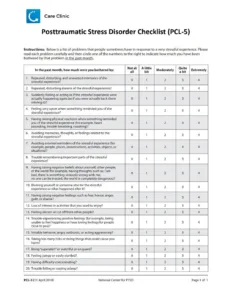
Post-traumatic stress disorder, commonly known as PTSD, affects millions of individuals worldwide. If you suspect that you may be experiencing symptoms of PTSD, seeking a proper diagnosis is crucial to receive appropriate treatment and support. Taking a PTSD test is a vital step towards understanding your mental health and embarking on a healing journey. In this comprehensive guide, we will explore what to expect during the testing process and how to adequately prepare for it.
Table of Contents
- Understanding Post Traumatic Stress Disorder: An Overview
- The Importance of PTSD Testing
- Different Types of PTSD Tests
- Preparing for a PTSD Test
- What to Expect During the PTSD Test
- Printable PTSD Test (PCL-5)
- CareClinic PCL-5 Online Test
- Benefits of Using the CareClinic App to take PCL-5 Online Test
- Interpreting Your PTSD Test Results
- Coping Mechanisms and Treatment Options for PTSD
- The Role of Support Systems in PTSD Management
Understanding Post Traumatic Stress Disorder: An Overview
Before diving into the details of PTSD testing, it is essential to have a basic understanding of the disorder itself. PTSD, or Post-Traumatic Stress Disorder, is a mental health condition that can develop after experiencing or witnessing a traumatic event. It can manifest with various symptoms that significantly impact an individual’s daily life and emotional well-being.
PTSD is not a new phenomenon. In fact, it has been recognized throughout history under different names. For example, during World War I, it was referred to as “shell shock,” as soldiers returning from the frontlines displayed symptoms such as nightmares, anxiety, and emotional distress. However, it wasn’t until the 1980s that PTSD was officially recognized as a diagnosable disorder.
Defining PTSD is crucial in order to understand its impact on individuals. It is characterized by a range of symptoms that persist beyond the traumatic event. These symptoms can include intrusive thoughts or memories of the event, nightmares, flashbacks, hypervigilance, avoidance of triggers, mood swings, and emotional numbness. Such symptoms can be severe and interfere with relationships, work, and overall quality of life.
One of the challenges of diagnosing PTSD is that the symptoms can vary from person to person. Some individuals may experience heightened anxiety and jumpiness, while others may struggle with persistent sadness and depression. Additionally, the severity and duration of symptoms can also differ, making it essential for healthcare professionals to conduct a thorough assessment.
Closer Look at the PTSD Symptoms
Triggers for PTSD symptoms can vary as well. Reminders of the traumatic event, such as certain smells, sounds, or visual stimuli, can elicit a strong emotional response in individuals with Post Traumatic Stress Disorder. For example, a combat veteran may experience a flashback when hearing a loud noise that resembles gunfire. These triggers can be unpredictable and can make day-to-day life challenging for those living with PTSD.
It is important to note that PTSD is not limited to individuals who have experienced military combat. Traumatic events can include natural disasters, physical or sexual assault, accidents, or witnessing violence. Any event that overwhelms a person’s ability to cope can potentially lead to the development of PTSD.
Understanding the complexity of Post Traumatic Stress Disorder is crucial in order to provide appropriate support and treatment for individuals affected by this disorder. In the next section, we will explore the different methods used in testing and diagnosing Post Traumatic Stress Disorder.
The Importance of PTSD Testing
Receiving a proper diagnosis of Post-Traumatic Stress Disorder (PTSD) is crucial for several reasons. PTSD is a mental health condition that affects individuals who have experienced or witnessed a traumatic event. It can have a profound impact on a person’s well-being and quality of life. By undergoing PTSD testing, individuals can gain a better understanding of their condition and access the appropriate care and support.
Early detection allows for timely intervention and treatment. With an accurate diagnosis, mental health professionals can develop a personalized treatment plan tailored to address the unique needs and challenges of individuals with PTSD. This may include various therapeutic approaches such as cognitive-behavioral therapy (CBT), eye movement desensitization and reprocessing (EMDR), medication, and support groups. Timely treatment can significantly improve outcomes and increase the chances of full recovery.
Obtaining an official diagnosis also helps to reduce the stigma surrounding mental health conditions. Unfortunately, there is still a significant amount of misunderstanding and discrimination associated with mental illnesses. However, by recognizing PTSD as a legitimate medical condition, just like any other physical illness, we can promote empathy, understanding, and support from friends, family, and the community. It allows individuals to feel validated in their struggles and encourages them to seek the help they need without fear of judgment.
The Vital Role of Testing and Early Detection
PTSD testing plays a crucial role in identifying individuals who may be at risk of developing the condition. For example, individuals who have experienced a traumatic event but have not yet exhibited symptoms of PTSD can benefit from early screening. This proactive approach enables mental health professionals to provide preventive interventions and support, potentially reducing the likelihood of developing full-blown PTSD.
Furthermore, accurate PTSD testing can help differentiate between PTSD and other mental health conditions that may have similar symptoms. This distinction is vital as it ensures that individuals receive the appropriate diagnosis and treatment. Misdiagnosis can lead to ineffective or even harmful interventions, delaying the recovery process and exacerbating symptoms.
The importance of PTSD testing cannot be overstated. It not only allows for early detection and treatment but also helps reduce the stigma surrounding mental health conditions. By recognizing PTSD as a legitimate medical condition and providing individuals with the support they need, we can create a more compassionate and inclusive society.
Different Types of PTSD Tests
When it comes to PTSD testing, mental health professionals employ various assessment tools to gather information regarding a person’s symptoms, experiences, and functional impairment.
PTSD, or Post-Traumatic Stress Disorder, is a mental health condition that can develop after experiencing or witnessing a traumatic event. It is characterized by symptoms such as flashbacks, nightmares, hypervigilance, and avoidance behaviors. To accurately diagnose and assess the severity of PTSD, mental health professionals use a combination of clinical interviews and self-report questionnaires.
Clinical Interviews
A clinical interview is a common approach that mental health professionals use to assess PTSD. During this interview, you will have a conversation with a trained professional who will ask you questions about your experiences, symptoms, and personal history. Open and honest communication is crucial during this process, as it helps the interviewer form an accurate diagnosis.
The clinical interview typically begins with the mental health professional asking about the traumatic event or events that may have led to the development of PTSD. They will inquire about the details of the event, your emotional and physical reactions at the time, and any subsequent symptoms you may have experienced. The interviewer may also ask about your current symptoms, such as nightmares, intrusive thoughts, or avoidance behaviors.
During the interview, the mental health professional will also explore your personal history, including any previous mental health conditions, past traumas, and family history of mental illness. This comprehensive assessment helps the interviewer understand the context of your symptoms and determine if there are any underlying factors contributing to your PTSD.
Self-Report Questionnaires
In addition to clinical interviews, mental health professionals often utilize self-report questionnaires to assess the presence and severity of PTSD symptoms. These questionnaires are designed to measure specific symptoms, such as flashbacks, nightmares, hypervigilance, and avoidance behaviors. Your answers to these questionnaires provide additional information that helps mental health professionals evaluate your symptoms and determine an appropriate diagnosis.
There are several well-established self-report questionnaires used in PTSD assessment, such as the Posttraumatic Stress Disorder Checklist (PCL-5) and the Impact of Event Scale-Revised (IES-R). These questionnaires consist of a series of statements or questions related to PTSD symptoms, and you will be asked to rate the frequency and severity of each symptom. Mental health professionals analyze your responses to these questionnaires to assess the severity of your symptoms and track changes over time.
It is important to note that while self-report questionnaires are valuable tools in PTSD assessment, they are not diagnostic on their own. The results of these questionnaires are typically used in conjunction with clinical interviews and other assessment measures to form a comprehensive understanding of your PTSD symptoms.
PTSD diagnostic and statistical manual involves a combination of clinical interviews and self-report questionnaires. The clinical interview allows mental health professionals to gather detailed information about your experiences, symptoms, and personal history, while self-report questionnaires provide additional insight into the presence and severity of specific PTSD symptoms. These assessment tools work together to help mental health professionals accurately diagnose PTSD and develop an appropriate treatment plan tailored to your individual needs.
Preparing for a PTSD Test
Preparing for a PTSD tests involve both mental and practical preparation strategies. It is important to approach this process with care and consideration for your well-being.
Mental Preparation Strategies
Before the test, it is essential to mentally prepare yourself by acknowledging and accepting the possibility of a PTSD diagnosis. This can be a challenging step, as it requires facing the potential reality of living with PTSD. However, by acknowledging and accepting this possibility, you are taking an important first step towards healing.
Educating yourself about PTSD can also help alleviate anxiety and provide you with a better understanding of the testing process. Learning about the symptoms, causes, and treatment options can empower you to actively participate in your own evaluation and subsequent treatment.
Additionally, it can be helpful to seek support from loved ones or a support group. Talking to others who have gone through similar experiences can provide you with a sense of community and understanding. Sharing your fears, concerns, and hopes with others who can relate can be incredibly comforting and reassuring.
What to Expect During the PTSD Test
When you arrive for your PTSD tests, it is natural to feel a mix of emotions, including anxiety, curiosity, and uncertainty. Understanding what to expect during the test can help ease some of these feelings.
As you step into the mental health professional’s office, you may notice a calming and welcoming environment. Soft lighting, comfortable seating, and soothing music may be present to create a safe space for you to share your experiences.
The Role of the Mental Health Professional
During the test, the mental health professional will guide the assessment process. They will ask you a series of questions designed to gather information about your experiences, symptoms, and daily functioning. It is important to be honest and open about your feelings and experiences during this time.
The mental health professional will approach the assessment with empathy and understanding. They have undergone extensive training to ensure they provide a supportive and non-judgmental environment for you to express yourself.
Printable PTSD Test (PCL-5)
The PCL-5 is a self-administered assessment that patients can fill out while waiting for their session or as part of a research study. Here’s a PTSD Checklist for DSM-5 (PCL-5):
⬇️ Printable Posttraumatic Stress Disorder Checklist (PCL-5) PDF
CareClinic PCL-5 Online Test
 PTSD Checklist for DSM-5 (PCL-5)
PTSD Checklist for DSM-5 (PCL-5)
PCL-5 scores can be used to plan and monitor treatment.
This is easy-to-use self-administered patient questionnaire that is used as a screening tool and severity measure for Depression.
This is not a diagnostic test. Please consult a licensed healthcare professional for diagnosis and treatment of medical conditions.
⬇️ Download the CareClinic App
Benefits of Using the CareClinic App to take PCL-5 Online Test
- On-the-Go Access: Take quizzes anytime, anywhere.
- Easy Sharing: Share results and content effortlessly with your caregiver or healthcare provider.
- Secure and Permanent: Quiz data is safely stored, preventing loss.
- Privacy Assurance: Personal data and quiz results are protected. Implement robust data security measures and clear privacy policies to give users confidence that their information won’t be misused or exposed to third parties.
- Trend Spotting: Easily identify and track performance trends for self-improvement and health management.
Interpreting Your PTSD Test Results
When utilizing PCL-5 severity scores to form a preliminary diagnosis, it’s important to take into account the specific attributes of the respondent’s environment. The purpose of the assessment should also be a guiding factor. If the objective is to enhance the identification of potential cases, it’s advisable to use a lower cut-off score, particularly during screening. Conversely, when the aim is to establish a preliminary diagnosis or reduce the likelihood of false positive results, a higher cut-off score should be considered.
Scores consist of a total symptom severity score (from 0 to 80) and scores for four subscales:
- Re-experiencing (items 1-5 – max score = 20)
- Avoidance (items 6-7 – max score = 8)
- Negative alterations in cognition and mood (items 8-14 – max
score = 28) - Hyper-arousal (items 15-20 – max score = 24)
Understanding your diagnosis is an important part of the healing process. It can validate your experiences and provide a framework for understanding your symptoms. A PTSD diagnosis can bring clarity to what you may be experiencing, helping you make sense of your emotions, thoughts, and behaviors. It can also help you realize that you are not alone in your struggles, as there are many others who have gone through similar experiences and received the same diagnosis.
Understanding Your Diagnosis
A PTSD diagnosis can validate your experiences and provide a framework for understanding your symptoms. It helps bring clarity to what you may be experiencing and determines the best course of treatment going forward.
Once you receive a PTSD diagnosis, it is important to remember that it does not define you as a person. It is simply a label that licensed mental health professionals use to describe a specific set of symptoms and experiences. Your diagnosis does not diminish your worth or define your future. Instead, it serves as a starting point for your healing journey.
Understanding your diagnosis involves learning about the specific symptoms of PTSD and how they may be affecting your life. Common signs of PTSD include intrusive thoughts or memories, flashbacks, nightmares, avoidance of triggers, negative changes in thoughts and mood, and hyperarousal. By understanding these symptoms, you can start to recognize them in your own experiences and gain insight into how they may be impacting your daily life.
Next Steps After Diagnosis
Once you receive a diagnosis, the licensed mental health professional will work with you to develop a comprehensive treatment plan. This plan may include various therapeutic modalities, such as cognitive-behavioral therapy, medication options, and lifestyle changes that can support your healing journey.
Cognitive-behavioral therapy (CBT) is a common treatment approach for PTSD. It focuses on helping you identify and change negative thought patterns and behaviors that contribute to your symptoms. Through CBT, you can learn coping skills and strategies to manage your symptoms and improve your overall well-being. In addition to therapy, medication may also be recommended as part of your treatment plan. Antidepressant medications, such as selective serotonin reuptake inhibitors (SSRIs), can help alleviate symptoms of depression and anxiety commonly associated with PTSD. Your mental health professional will carefully consider your individual needs and circumstances when determining whether medication is appropriate for you.
Furthermore, lifestyle changes can play a significant role in your recovery from PTSD. Engaging in regular physical exercise, practicing relaxation techniques such as deep breathing or meditation, maintaining a healthy diet, and getting enough sleep can all contribute to your overall well-being. These lifestyle changes can help reduce stress, improve mood, and enhance your ability to cope with the challenges of PTSD.
It is important to remember that recovery from PTSD is a journey that takes time and effort. Your mental health professional will be there to support you every step of the way, providing guidance, encouragement, and reassurance. Together, you will work towards healing and regaining control of your life.
Coping Mechanisms and Treatment Options for PTSD
Living with PTSD can be challenging, but there are numerous coping mechanisms and treatment options available to help manage symptoms and improve your overall well-being.
Therapy and Counseling Options
Cognitive-behavioral therapy (CBT), eye movement desensitization and reprocessing (EMDR), and exposure therapy are just a few examples of evidence-based therapies that can help treat PTSD. These therapies aim to help individuals process their traumatic experiences, develop healthy coping strategies, and regain control over their lives.
Medication and Natural Remedies
In certain cases, medication may be prescribed to manage common signs of PTSD. Antidepressants, anti-anxiety medications, and sleep aids are commonly used to alleviate specific symptoms. Additionally, some individuals find natural remedies such as mindfulness practices, yoga, and meditation helpful in managing their symptoms.
The Role of Support Systems in PTSD Management
Creating and maintaining a strong support system is essential in managing PTSD.
Family and Friends
Open communication with loved ones can help them understand your needs and provide assistance and support when necessary. Educating them about PTSD can foster empathy and enable them to be valuable allies on your healing journey.
Support Groups and Communities
Connecting with support groups or online communities composed of individuals with similar experiences can provide a sense of belonging and understanding. Sharing stories, insights, and coping strategies with others who genuinely empathize can be immensely beneficial in managing PTSD.
Taking a PTSD test is an essential first step towards understanding and managing your mental health. From understanding the common signs of PTSD to preparing for the test and interpreting the results, this guide has provided valuable information to help you navigate the process. Remember, seeking a diagnosis is a proactive and courageous act that can lead you towards a better quality of life and renewed hope for the future.




